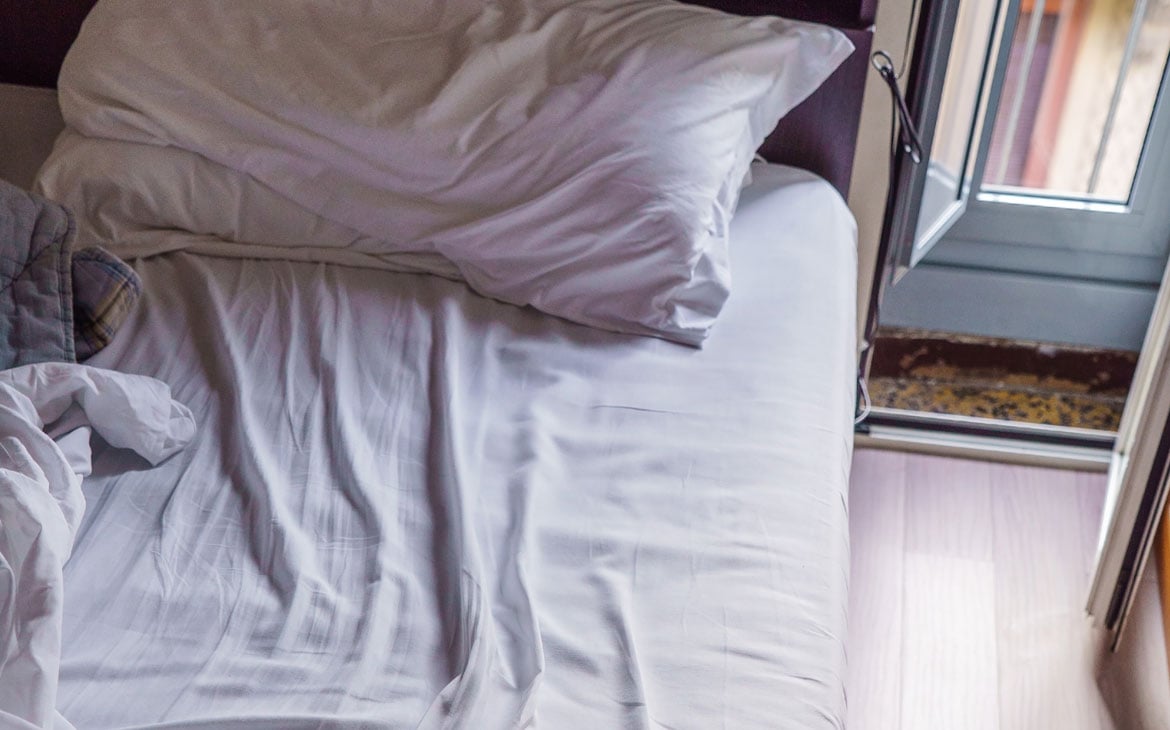Key Takeaways
- What Lurks Inside Mattresses: Mattresses often contain harmful chemicals like VOCs, formaldehyde, flame retardants, and benzene, which can lead to various health issues.
- Look for Certified Materials: When searching for a new mattress, look for reputable third-party certifications such as GREENGUARD and Oeko-Tex to ensure a safer and healthier option for lower chemical exposure.
- Protect Yourself Until You Can Purchase a New Mattress: In the meantime, consider investing in a polyethylene mattress cover to minimize exposure to these chemicals and protect your health until you can purchase a safer mattress.
If you’re one of the lucky people who tend to fall asleep at night without a problem, please accept our apologies.
What you’re about to hear might make it little harder to snooze soundly at night.
Chances are, your mattress is home to some pretty icky stuff. And we’re not talking about dust mites, dirt from weird stains, or dog hair.
We’re talking about chemicals.
What’s Really in Your Mattress
Whether you have a memory foam mattress or a traditional innerspring model, chances are most of that cushy material is polyurethane foam, the synthetic chemical that comes from petroleum.
Yup. Chances are, you’re sleeping on a fossil fuel-based mattress. Which in itself can seem a little strange.
But it gets worse: Polyurethane foam contains volatile organic compounds, or VOCs. VOCs include a range of different chemicals, but the one thing they all have in common is that they’re slowly released into the air at room temperature.
Which means they’re insanely easy to breathe in while you’re sleeping.
A sampling of conventional mattresses tested…found that the sleep surfaces contained a whopping 61 different VOCs.
In fact, when Sleep Safe in a Toxic World author Walter Bader had a sampling of conventional mattresses tested by an independent lab, they found that the sleep surfaces contained a whopping 61 different VOCs.
Which ones might be hanging out in your bed? It’s tough to know for sure, since there’s not much regulation around what manufacturers can or can’t use in their mattress—or what they’re required to disclose.
Still, there’s a pretty good chance that these toxic nasties might make the list:
- Formaldehyde A preservative used as an adhesive in mattress, formaldehyde can irritate the nose, throat, and skin, and could increase the risk for coughing and wheezing, according to the EPA. Verified Source Environmental Protection Agency (EPA) Works to control/prevent natural and manmade disasters. View source
- Polybrominated diphenyl ethers Flame retardants linked to reduced fertility and hormonal changes, as well as lower birth weight, lower IQ, and hyperactivity in kids, says the Green Science Policy Institute.
- Benzene A known carcinogen Verified Source World Health Organization (WHO) United Nations agency whose stated goal is to improve the health of all. View source that occurs naturally in petroleum.
- Toulene diisocyanates Used to make foams more flexible, toluene diisocyanates are thought to be human carcinogens, according to a report from the National Institutes of Health. Verified Source National Library of Medicine (NIH) World’s largest medical library, making biomedical data and information more accessible. View source
- Polyols They’re used to add bulk and help bind polyurethane foams. And though some polyols are derived from soybeans and other natural sources, the majority come from petroleum.
Buying a Better Mattress

Is it possible to find a mattress that isn’t loaded up with questionable chemicals? The good news is yes. The bad news? The shopping process isn’t exactly straightforward.
Because there’s zero regulation when it comes to what counts as an “organic” or “natural” mattress, you’ll have to do some homework before handing over your credit card if you want to find the best mattress of 2024. If a mattress manufacturer makes green claims, dig a little deeper to find out exactly how their products are made.
If the process is actually green, finding that information from a manufacturer will probably be pretty easy. Amerisleep, for instance, is up-front about the fact that we use a high proportion of plant-based ingredients.
Even so, don’t just take the manufacturer at their word. You should also check to see whether its been verified by a reputable third-party certifier. A few to look for:
![]()
GREENGUARD The gold standard in third-party certifiers, GREENGUARD certified mattresses and bedding are screened for over 10,000 chemicals, including VOCs.
![]()
Oeko-Tex certified fabrics, including those used in mattresses, are independently tested for harmful substances commonly used in textile manufacturing.
How to Protect Yourself Right Now
Not in the market to buy a new, safer mattress right now? We hear you. Buying a new bed isn’t exactly something most of us can afford to do on the fly—especially when it comes to greener options.
So how can you minimize your VOC exposure? Consider investing in a polyethylene mattress cover. It can act as a barrier to keep some of the chemicals in your mattress instead of out in the air that you breathe.
[A polyethylene mattress cover] is the only safe material that can actually stop VOCs from off-gassing.
Yes, it’s a plastic—but it’s one that’s considered safe and nontoxic. And according to experts at Healthy Child Healthy World, it’s the only safe material that can actually stop VOCs from off-gassing into your indoor environment. (Cotton covers aren’t woven tightly enough to block chemicals.) Another benefit is that the covers keep your mattress clean and healthy, too.
And when you do decide to take the plunge on a new mattress? Here’s how to find one without breaking the bank.
About the author
Marygrace Taylor is an award-winning health writer for Amerisleep. Her commitment to sleep health is evident in her ability to consistently prioritize eight hours of sleep each night. Her in-depth interviews with industry experts, such as Ken Ceder on "Why Light is Essential for Great Sleep and Optimum Health," highlight her dedication to delivering valuable insights. Marygrace's work has been featured in reputable publications like Business Insider, Glamour, Refinery29, Metro UK, and Hunker, further solidifying her expertise in the field.
View all posts





